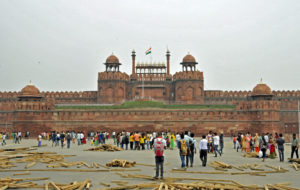
Lahori Gate of Red Fort in Old Delhi, India (Photo by Don Knebel)
Shan Jahan became the fifth Mughal Emperor in 1628 after the death of his father. With the Taj Mahal still under construction, Shan Jahan moved his capital from Agra to Delhi. In 1639 he commissioned a fortified palace and government center on a 250-acre site south of the Yamuna River that also passes behind the Taj Mahal. The fort was built primarily of red sandstone, providing its name. Subsequent Mughal buildings copied its distinctive style, combining architectural details from India, Europe and Persia. The Lahori Gate, the main entrance to the fort, is topped by seven white domes and flanked by octagonal towers, each topped with a dome.
In 1857, Indian soldiers initiated a rebellion against the rule of the British East India Company. The uprising failed and British forces occupied the Red Fort, where they put on trial Bahadur Shah II, the last Mughal emperor. The British then used the fort as a garrison, damaging marble buildings inside the walls. Many of the treasures of the Red Fort, including the last emperor’s crown, are in the British Museum. On August 15, 1947, Prime Minister Jawaharlal Nehru raised the Indian National flag above the Lahori Gate, signaling India’s independence. On each Independence Day since, the prime minister has raised the flag and given a major speech to crowds assembled in front of the Lahori Gate.
The Red Fort, with many of its interior structures restored and turned into museums, was named a UNESCO World Heritage site in 2007 and is open to the public. A visit provides a look at India’s glorious history.
Comments are closed.